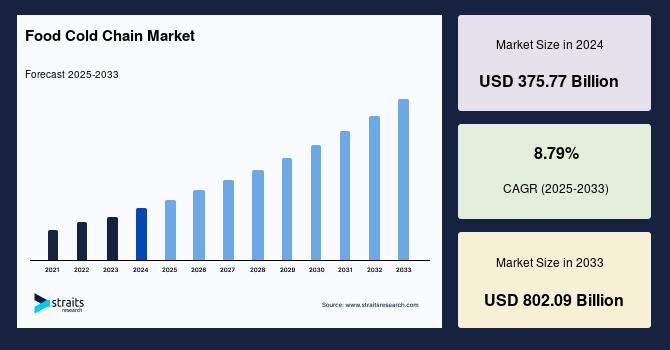Food Cold Chain Market: Pivotal Growth in Preserving Perishables and Reducing Waste

The food cold chain market size was valued at USD 375.77 billion in 2024 and is projected to grow from USD 408.80 billion in 2025 to reach USD 802.09 billion by 2033,exhibiting a CAGR of 8.79% during the forecast period (2025-2033). This growth reflects the imperative need to maintain the quality and safety of perishable goods through refrigerated storage, transport, and distribution, while addressing global concerns around food waste and supply chain risks.
Importance and Scope of the Food Cold Chain
Cold chains are temperature-controlled logistics networks encompassing refrigerated warehouses, transport vehicles, and advanced packaging solutions designed to preserve the integrity of temperature-sensitive products from origin to consumer. The food industry relies heavily on these systems to protect perishable goods such as fruits, vegetables, meat, seafood, dairy, frozen desserts, bakery items, and ready meals, which are vulnerable to spoilage, contamination, and nutritional degradation.
Globally, food waste remains a significant challenge, with organizations estimating that nearly one-third of food produced for human consumption is lost or wasted annually. These losses translate not only into economic setbacks but also environmental harm due to wasted water, land, and energy, as well as increased greenhouse gas emissions. The cold chain provides an effective solution by extending shelf life, reducing spoilage during transport and storage, and maintaining product safety, thereby supporting global food security and sustainability goals.
Market Drivers and Innovation Trends
The growing consumer preference for fresh and convenient food options has bolstered demand for refrigerated and frozen products. Urbanization, rising disposable incomes, and shifts in dietary patterns, especially in developed regions, have underscored the need for efficient cold storage and transportation.
Technological advancements are revolutionizing the market, with innovations like real-time data trackers, blockchain for traceability, and IoT-enabled sensors improving temperature monitoring and supply chain transparency. These technologies mitigate risks of temperature excursions and quality degradation, enhance regulatory compliance, and optimize operational efficiency.
The market leverages renewable energy sources such as solar and wind power to reduce operational costs and environmental impact. Additionally, automation trends including robotics, AI, and even drone-based delivery systems, are emerging to streamline cold chain logistics.
Regional Market Dynamics
North America dominates the food cold chain market, attributing its leadership to widespread adoption of advanced cold storage infrastructure, regulatory frameworks ensuring product safety, and a strong presence of major retail and food service players. The demand for organic and temperature-sensitive food products has amplified the need for sophisticated supply chain solutions.
Europe is witnessing significant growth, fueled by increasing imports, stringent food safety regulations, and consumer demand for quality frozen and refrigerated items. Countries like Spain and the UK play vital roles with their export-oriented fresh produce and processed food sectors.
The Asia-Pacific region stands as the fastest-growing market, driven by rapid urbanization, expanding middle-class populations, modernization of logistics systems, and the rise of e-commerce platforms catering to fresh and frozen foods in countries such as China, India, Japan, and South Korea. Despite infrastructure challenges in some developing areas, investments in cold storage facilities and transportation are accelerating.
Emerging markets in Latin America, the Middle East, and Africa are also gaining traction. Brazil’s robust beef export industry benefits from cold chain enhancements, while increased regulatory focus on food safety in countries like Argentina is fostering growth in cold storage and distribution.
Market Segmentation and Key Players
Applications within the market are diverse. The meat and seafood segment represents the largest share due to the perishability and high demand for these products globally. Increased meat consumption per capita is expected to push investments in cold chain solutions for consistent quality and safety.
Fruits and vegetables account for a growing segment, especially important for export economies where preventing post-harvest losses is critical. Cold chain ensures reduced spoilage and extended transportation distance, addressing challenges posed by inadequate logistics in supply-constrained regions.
Other significant segments include dairy and frozen desserts, bakery and confectionery, and ready-to-eat meals. Consumer trends favor convenience foods with longer shelf lives but maintained nutritional value and taste, emphasizing the value cold chain technologies provide.
Leading companies focus on integrating advanced technologies, sustainable practices, and expanding storage capacities to meet surging demand. Investments in blockchain, AI-powered monitoring systems, and smart warehousing ensure end-to-end visibility and minimize disruptions.
Challenges and Opportunities
While the market faces challenges such as high operational costs, energy-intensive refrigeration, and infrastructure gaps in developing regions, these also create avenues for innovation. Improving energy efficiency, adopting renewable energy sources, and optimizing supply chain networks are priorities.
Increasing awareness toward reducing food waste, along with supportive government initiatives globally, catalyzes further investment in cold chain infrastructure. The surge in online grocery shopping and food delivery services post-pandemic continues to drive demand for temperature-controlled logistics.
Sustainability remains a central concern, prompting stakeholders to seek eco-friendly packaging, cold chain solutions with reduced carbon footprints, and circular economy practices.
Conclusion
The food cold chain market is poised for transformative growth, integral to global efforts in enhancing food safety, minimizing waste, and ensuring the efficient delivery of perishable goods. As consumer preferences evolve and technological advancements accelerate, the industry will continue to innovate, expanding its reach and capability. With a balanced focus on operational excellence, sustainability, and consumer trends, the food cold chain market will remain a critical pillar in the modern food supply ecosystem well into the future.
- Art
- Causes
- Crafts
- Dance
- Drinks
- Film
- Fitness
- Food
- Games
- Gardening
- Health
- Home
- Literature
- Music
- Networking
- Other
- Party
- Religion
- Shopping
- Sports
- Theater
- Wellness


